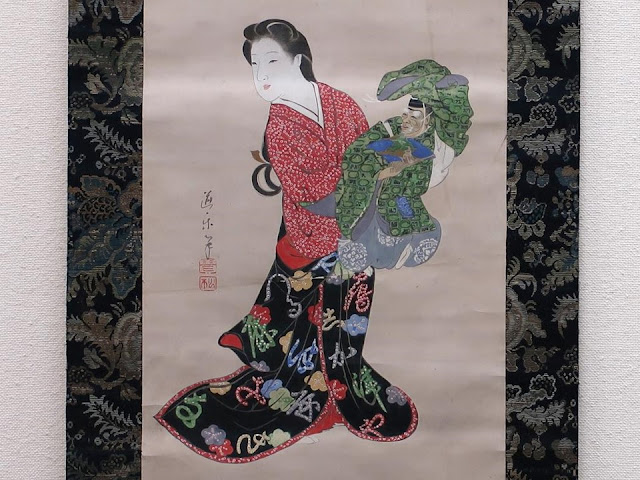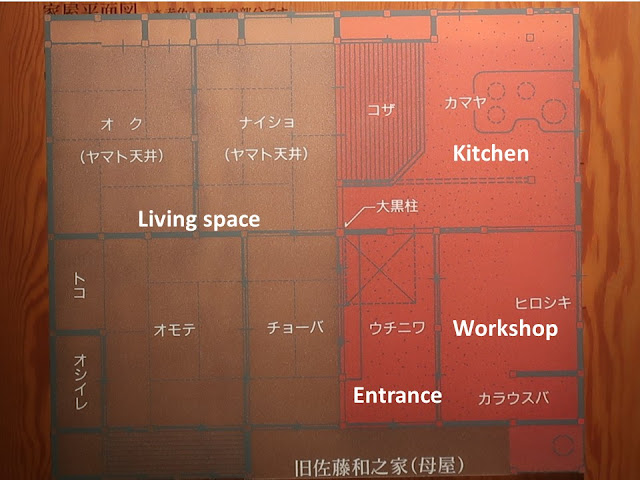Matsushige town is located at the mouth of Yoshino River in Shikoku Island (Tokushima prefecture). It is a lowland, so they have suffered from floods.
On the other
hand, Joruri puppet show has flourished here for a long time. The report
in 1971 says that the number of Joruri puppet show stage in Tokushima is 208
which accounts for 96% of the total number of stages in the rural area in
Japan. Villagers who watch or play the show look happy. The shows entertain
people even until now.
There are many children in the first row, but I doubt they can understand the storyline, because the major programs of Joruri are Jidaimono (historical topics) and Sewamono (accidents in the city such as a lover’s suicide which are far from Disney). However, children also play Joruri puppet shows, so it might be popular among children.
最前列は子供たちが多いのですが、ストーリーが分かるのかなあ。落語の演目に芝居好きの子供の話がありますが、当時は、子供たちも分かったのかも知れませんねえ。子供の太夫の展示もあります。
Impassioned performance: the papers in front show the names of donators who sent flowers or money and ones of receptors (performers). It’s so popular.
舞台の熱演。寄付者の名前が張り出されています。広告を出したくなるほど、人気だったのでしょう。
1844年、庄屋をはじめ農民が郡代に人形浄瑠璃の興行願いを出しています。「地神祭りとして百姓ども申し出ます。早朝から始め夕七つ時限りで終わります。若者共が喧嘩口論をせぬようします」などと書かれていて、夜遅くまで盛り上がっていたことが分かります。ぼけた写真ですみません。
The Joruri group, who practice and perform in this museum, is recruiting members. It’s good.
座員募集しています。いいね!
Exhibition room of Joruri、人形浄瑠璃の展示室
Exhibits about child players: the photos are heartwarming.
豆義太夫のコーナー。子供たちが演じる写真が微笑ましいです。
「どんなもんだい」。人形浄瑠璃に出演できるということは、まず、かっこいい、ということだったのでしょう。
豆義太夫と、心配して覗いているおばあさん。
Stage properties and dolls、人形浄瑠璃の道具と人形
This ghastly doll is “Oshichi” who is the heroin of a lovers’ suicide play. Made by Hisa Tengu.
天狗久作「お七」。鬼気迫っています。
Dolls made by masters: painting technique was introduced from Kyoto by the master of Tengu.
天狗久の孫・天狗治(はる)作の人形と天狗久の師匠・人形富作の頭。人形富は徳島に御所人形の技術を伝えました。
This puppeteer is attractive.
くぐつ女操(おんなあやつり)の道楽画。女の表情が良いです。
Utamaro Kitagawa who was the famous Ukiyoe artist created this enticing picture. The puppets who will commit suicide are sexy and puppeteers are erotic.
喜多川歌麿筆「音曲恋の操(みさお) 梅川・忠兵衛」:人形たちが艶めかしく、操る男女もエロいです。何とも言えない絵ですねえ。
“Bunraku dolls” by Yumeji Takehisa who is popular even until now, shows his touch well.
Reference (Yumeji Takehisa, Wiki): https://en.wikipedia.org/wiki/Yumeji_Takehisa
竹久夢二「文楽人形」:夢二が書くとこうなる、なるほどですね。
We can operate this doll head.
レバーで人形の頭を動かせます。
Music stand: this is made in the Showa period (1926-1989), but it has the crest of the great samurai family on it.
立派な見台。昭和の作ですが、源氏の引両(ひきりょう)の紋が光ります。
Shamisen guitars (thick neck type) make strong sound.
太棹の三味線も昭和の作ですが、力強い音が出そうです。
It is written, “There is no musical score of shamisen, but there are notes about sound in this book.” It’s a pity that we have no musical score to inherit their music.
「三味線は音で学ぶと言われたが、音の注記があるというのはめずらしい」と書かれています。五線譜がないのは、文化的に残念。
Hokusai’s printing is exhibited. His picture is really dynamic.
Reference: Sumida Hokusai Museum すみだ北斎美術館
北斎の絵はここにもありました。凄いですねえ、絵が生きています。
Picture roll below was made by Shikou Munakata (famous printmaker)
下の巻物は、棟方志功作。こちらも迫力があります。
History of Awa Joruri、阿波人形浄瑠璃の歴史
Puppet shows originated around one thousand years ago, then it consolidated Tayuu (story teller) and Shamisen guitar. It is Joruri. In the Edo period (1603~1868), it flourished. Awa Joruri which is the one in this area was brought from Awajishima Island early in the 17th century.
Reference (diary of samurai who was a Joruri freak):元禄御畳奉行の日記 The diary of samurai officer "Genroku Otatami Bugyo" in the early Edo period (published in 1984)
平安時代に始まった人形操りは、鎌倉時代に盛んになった語り物の太夫(たゆう)、室町時代末期にできた三味線と結びついて人形浄瑠璃になりました。江戸初期に人気が高まり、近松門左衛門、竹本義太夫の登場でピークになりました。阿波人形浄瑠璃は、17世紀の初め、淡路から伝わった、とあります。
Joruri is played once a month at this stage.
毎月、人形浄瑠璃が行われるスペース
History and folklore of Matsushige town、松茂町の歴史と民俗
Agricultural tools: the ruler was used to plant rice seedlings at even intervals. It is very Japanese, I think.
農機具:苗を等間隔に植えるための田植定規は、きっちりした日本人らしい道具だと思います。
Fishing tools: the flags called “Tairyou (big catch)-ki (flag)” are eye catching.
漁具:大漁旗が目立ちます。
In the entertainment area, festivals are introduced mainly.
楽しみのコーナーは、祭の展示です。
I felt people’s enthusiasm via video.
祭の熱気が、ビデオ映像とともに伝わります。
Layout of a traditional private house
松茂の民家のレイアウト
Entrance (full scale model)、民家の入り口(実物大展示)
The kitchen is behind the hanging wall which is a smoke barrier. This was the first time to see the smoke barrier wall, it’s really reasonable. Because living rooms become very smoky while cooking.
煙返しという垂れ壁越しに見る台所:煙が居室に流れるのを防ぎます。効果抜群だと思います。
Smoke while cooking、かまどを使っている台所
Tokushima city、徳島市内
Sakura cherry blossoms at the ruined Tokushima castle reached full bloom.
徳島城跡の桜、咲き誇っていました。
Gear for pilgrim: many pilgrims including foreigners travel to Shikoku Island, some on foot. Because there are eighty-eight temples which are related to Kukai who was the founder of Kouyasan and Shingon Buddhism sect, they visit them. And the local people treat them. They have an idea that every pilgrim travels with Kukai “同行二人”. It is printed on the outfit. Pilgrims are called "O-henro-san お遍路さん".
徳島駅前のお遍路さん用具のショーケース。四国に来た!、という感じがします。弘法大師が生まれたのは四国・香川です。「同行二人」ですね。
Seven funs(楽fun)were found. Visited in April, 2019
Official website: http://www.joruri.jp/(in Japanese), accessed
in October, 2020
Previous post (Kukai’s temple):
Next post (Museum
in the western Japan where powerful warlord was):
Hofu city and Cultural assets museum、防府市と文化財郷土資料館









































Comments
Post a Comment